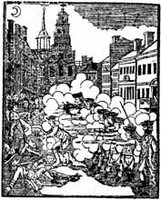James Brewer at the Boston Massacre, part 3
 The published transcript of the trial of soldiers for the Boston Massacre, possibly the first ever attempted in America, doesn’t indicate when the questioning of witnesses switched from prosecution to defense. So I’m guessing at that point in blockmaker James Brewer’s testimony, based on when the questions double back to the beginning of his account and start reviewing the same points.
The published transcript of the trial of soldiers for the Boston Massacre, possibly the first ever attempted in America, doesn’t indicate when the questioning of witnesses switched from prosecution to defense. So I’m guessing at that point in blockmaker James Brewer’s testimony, based on when the questions double back to the beginning of his account and start reviewing the same points.
The soldiers’ legal team—Robert Auchmuty, John Adams, and Josiah Quincy, Jr.—were trying to make a case for self-defense. So they started by homing in on why Brewer had thought sentry Hugh White seemed scared before turning to what else he might have seen. Quincy, as junior member of the team, probably handled the questioning; Adams was taking detailed notes on Brewer’s remarks, which survive.
Q: How came you to to speak to the Sentry, and tell him not to be afraid?Many other witnesses had testified and would testify to seeing civilians, including Crispus Attucks, carrying cordwood sticks. Even though Brewer recalled Attucks standing “just before me,” he recalled nothing of the sort. Many people testified that the crowd yelled insults at the soldiers (and vice versa). Several people said that others threw snowballs and harder objects at the soldiers. Brewer, however, had developed an Alberto Gonzales-like ability to not see or remember any bad behavior by his comrades.
B: Because he was swinging his gun in that manner.
Q: Did you come up Royal-exchange-lane?
B: Yes. I saw Doctor [Thomas] Young there, and several others coming up to know where the fire was; Doctor Young said it was not fire, but the soldiers had made a rumpus, but were gone to their barracks again. [This was the fight at Murray’s barracks.] Then said I let every man go to his own home.
Q: Did you see any thing thrown at the soldiers?
B: No.
Q: Did you hear any body call them names?
B: No.
Q: Did you hear any threatning speeches?
B: No; except that the people cryed fire!—fire!—the word fire was in every body’s mouth.
Q: Just before the firing, when [Pvt. Mathew] Killroy struck you, was there any thing thrown at the soldiers then?
B: I saw nothing.
Q: Was there a number of people betwixt you and the soldiers?
B: Not many.
Q: Did you see [merchant Richard] Palmes talking with Capt. [Thomas] Preston?
B: No; I saw the molatto fellow [Crispus Attucks] there, and saw him fall.
Q: Did you see a party of people like sailors, coming down from the Jackson’s corner, with sticks?
B: No, I saw none.
Q: Where did you first see the molatto?
B: He was just before me by the gutter.
Q: Did you see any people coming from Quaker-lane with sticks?
B: I saw several inhabitants coming through that lane, but I saw no sticks.
Q: Were there any coming up Royal Exchange lane?
B: Yes, numbers, but I saw no sticks.
Q: When you first saw the molatto, did you hear him say any thing to the soldiers, or strike at them?
B: No.
Q: Had he a stick or club?
B: I did not take notice.
COMING UP: The end of the questioning—and a loose thread.

4 comments:
I've been reading Brewer's testimony and the discussion about the Massacre with great interest. I am a documentary producer from Lexington working on another History Channel program which features a re-enactment of the Boston Massacre. We shot it in July at the Statehouse with the 5th Foot and about 40 assorted colonial "mobsters." Hearing concerns expressed about previous shows, we tried to make it as accurate as possible (although highly compressed).We consulted with historian Robert Allison as well as with Mike Monahan, commander of the 5th Foot. Although we leave a lot out (it is, after all, a four minute segment), I hope that what is in there gives a good feel for the event. The show is about restoration work at the Old State House and the African meeting House, and will air September 22 at 8 PM on The History Channel.
Thanks for the comment. I heard about this filming from Mike Monahan and Graeme Marsden, so I knew you were working with the right reenactors. I sent Graeme a message about exactly what to look for in a Crispus Attucks portrayer, though we agreed that all the specs would be hard to come by.
I was a little surprised at the idea of recreating an event that included snowballs in July, but I guess you film with the weather you have, not the weather you want to have!
You mention that Adams was taking "detailed notes on Brewer’s remarks, which survive" - could you possibly share "where" one might search for those notes? Thank you! Love your blog - amazing wealth of information!!!
John Adams’s notes on the Massacre trial are published in the third volume of the Legal Papers of John Adams, published by Harvard University Press. I believe the original documents are part of the Adams Family Papers held at the Massachusetts Historical Society.
Post a Comment